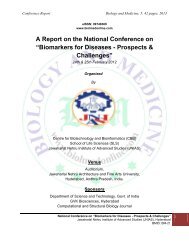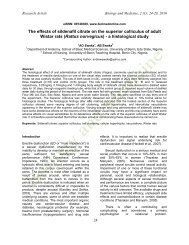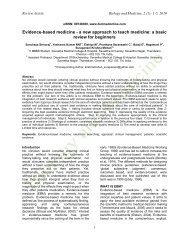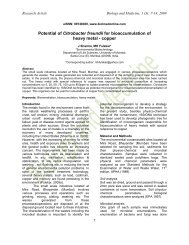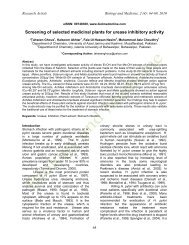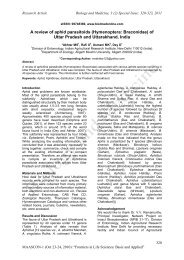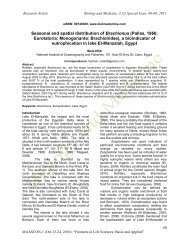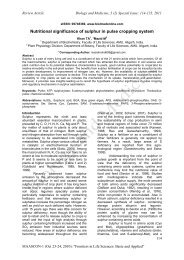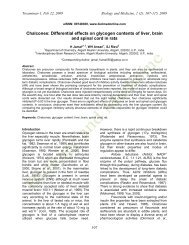Immunomodulatory effects of Tinospora cordifolia (Guduchi) on ...
Immunomodulatory effects of Tinospora cordifolia (Guduchi) on ...
Immunomodulatory effects of Tinospora cordifolia (Guduchi) on ...
Create successful ePaper yourself
Turn your PDF publications into a flip-book with our unique Google optimized e-Paper software.
Research Article Biology and Medicine, 3 (2) Special Issue: 134-140, 2011<br />
Himalaya Drug Company, India. All other<br />
chemicals and solvents used in this study<br />
were obtained from Sigma Chemical Company<br />
(St. Louis, USA) and were <str<strong>on</strong>g>of</str<strong>on</strong>g> analytical grade<br />
or the highest grade available.<br />
Cells: The macrophage J774A.1 cell line,<br />
purchased from Nati<strong>on</strong>al Center for Cell<br />
Sciences (NCCS, Pune), was used as source<br />
<str<strong>on</strong>g>of</str<strong>on</strong>g> macrophages (Origin: BALB/c mouse;<br />
Nature: Mature), grown and maintained in the<br />
RPMI 1640 medium (pH 7.2-7.4) enriched with<br />
10% Fetal Bovine Serum, at 37 0 C and 5% CO2<br />
envir<strong>on</strong>ment.<br />
Viability assay: Cell viability was determined<br />
by the Trypan blue dye exclusi<strong>on</strong> technique.<br />
Equal volumes <str<strong>on</strong>g>of</str<strong>on</strong>g> cell suspensi<strong>on</strong>s were mixed<br />
with 0.4% Trypan blue in PBS, and the<br />
unstained viable cells were determined. These<br />
cells were further used for cytotoxicity assay in<br />
2 x 10 6 density per ml in the 96 well tissue<br />
culture plate.<br />
Stimulati<strong>on</strong> <str<strong>on</strong>g>of</str<strong>on</strong>g> macrophages: The macrophage<br />
cells (cell line J774A) from late log phase <str<strong>on</strong>g>of</str<strong>on</strong>g><br />
growth (subc<strong>on</strong>fluent) were seeded in 96 well<br />
flat bottom microtitter plates (Tars<strong>on</strong>s, India) in<br />
a volume <str<strong>on</strong>g>of</str<strong>on</strong>g> 100µl under adequate culture<br />
c<strong>on</strong>diti<strong>on</strong>s. Drugs were added in different<br />
c<strong>on</strong>centrati<strong>on</strong>s in a volume <str<strong>on</strong>g>of</str<strong>on</strong>g> 100µl in<br />
triplicate. The cultures were incubated at 37 0 C<br />
and 5% CO2 envir<strong>on</strong>ment. After 24 hr and 48<br />
hr incubati<strong>on</strong> percent viability was checked<br />
and culture supernatants were collected and<br />
assayed for nitric oxide and lysozyme activity.<br />
Cytotoxicity assay: In order to detect the<br />
toxicity <str<strong>on</strong>g>of</str<strong>on</strong>g> herbal preparati<strong>on</strong> the cytotoxicity<br />
assay was standardized by using 3-(4,5<br />
dimethylthiazol-2-yl)-2,5-diphenyltetrazolium<br />
bromide (MTT) at different time intervals for<br />
24 hrs and 48 hrs (Mosmann, 1983) using the<br />
drug at various c<strong>on</strong>centrati<strong>on</strong>s. After 24 hrs<br />
and 48 hrs <str<strong>on</strong>g>of</str<strong>on</strong>g> incubati<strong>on</strong>, supernatants were<br />
collected and ten microlitres <str<strong>on</strong>g>of</str<strong>on</strong>g> MTT (3 mg/ml)<br />
was added to each well and plates were<br />
further incubated for 2 hrs. The enzyme<br />
reacti<strong>on</strong> was then stopped by additi<strong>on</strong> <str<strong>on</strong>g>of</str<strong>on</strong>g> 150ul<br />
<str<strong>on</strong>g>of</str<strong>on</strong>g> dimethyl sulphoxide (DMSO). Plates were<br />
incubated for 10 min under agitati<strong>on</strong> at room<br />
temperature before the optical density at<br />
570nm was read under an ELISA plate reader.<br />
Three independent experiments in triplicate<br />
were performed for the determinati<strong>on</strong> <str<strong>on</strong>g>of</str<strong>on</strong>g><br />
sensitivity to each drug. Cells treated with<br />
medium al<strong>on</strong>e were c<strong>on</strong>sidered as C<strong>on</strong>trol.<br />
Percent viability was calculated by the given<br />
formula.<br />
Percent viability = E x 100<br />
C<br />
where E is the absorbance <str<strong>on</strong>g>of</str<strong>on</strong>g> treated cells and<br />
C is the absorbance <str<strong>on</strong>g>of</str<strong>on</strong>g> untreated cells.<br />
Nitrite assay: The c<strong>on</strong>centrati<strong>on</strong> <str<strong>on</strong>g>of</str<strong>on</strong>g> stable<br />
nitrite, an end product <str<strong>on</strong>g>of</str<strong>on</strong>g> the nitric oxide<br />
present in the supernatant <str<strong>on</strong>g>of</str<strong>on</strong>g> treated or<br />
untreated J774A macrophage cell cultures (2 x<br />
10 6 cells/ml), was measured by the method <str<strong>on</strong>g>of</str<strong>on</strong>g><br />
(Ding et al.,1988) based <strong>on</strong> the Griess<br />
reacti<strong>on</strong>. Briefly, 50 ul <str<strong>on</strong>g>of</str<strong>on</strong>g> supernatant was<br />
incubated with an equal volume <str<strong>on</strong>g>of</str<strong>on</strong>g> Griess<br />
reagent (1% sulphanilamide in 2.5 % H3PO4<br />
and 0.1% naphthyl-ethylene-diaminedihydrochloride<br />
in distilled water; both<br />
soluti<strong>on</strong>s mixed in a ratio <str<strong>on</strong>g>of</str<strong>on</strong>g> 1:1 at room<br />
temperature) for 10 min. The absorbance at<br />
550 nm was then measured in a microtitre<br />
plate reader. The standard curve for nitrite was<br />
prepared by using 10-100 µM sodium nitrite in<br />
distilled water.<br />
Assay for lysozyme: Lysozyme assay was<br />
performed with culture supernatants from<br />
treated and untreated macrophage cultures by<br />
the method described by Litwack (1955). A<br />
substrate suspensi<strong>on</strong> <str<strong>on</strong>g>of</str<strong>on</strong>g> dried and killed<br />
Micrococcus luteus (0.1 mg/ml) was prepared<br />
in 0.1 M sodium phosphate buffer at pH 6.2<br />
and 0.1 ml culture supernatant collected from<br />
treated and untreated macrophages were<br />
added to each tubes c<strong>on</strong>taining 2.5 ml <str<strong>on</strong>g>of</str<strong>on</strong>g><br />
substrate buffer kept at 37 0 C. Optical density<br />
at 600 nm was checked at zero hour <str<strong>on</strong>g>of</str<strong>on</strong>g><br />
incubati<strong>on</strong>. The tubes were then incubated at<br />
37 0 C for 1 hr and decrease in optical density<br />
was checked at 600 nm. Experiments were<br />
repeated three times in triplicates and enzyme<br />
activity expressed in units/ml culture<br />
supernatant / 2 x 10 6 cells / ml.<br />
Kirby-Bauer antibiotic testing or disk diffusi<strong>on</strong><br />
antibiotic sensitivity testing:<br />
The antibacterial susceptibility has been<br />
checked by using the Kirby-Bauer method<br />
(Williams, 1990; NCCSL, 1984; WHO, 1961).<br />
This method is used for testing the<br />
antimicrobial susceptibility <str<strong>on</strong>g>of</str<strong>on</strong>g> bacteria based<br />
<strong>on</strong> the size <str<strong>on</strong>g>of</str<strong>on</strong>g> z<strong>on</strong>es <str<strong>on</strong>g>of</str<strong>on</strong>g> inhibiti<strong>on</strong> <str<strong>on</strong>g>of</str<strong>on</strong>g> growth <str<strong>on</strong>g>of</str<strong>on</strong>g> a<br />
lawn culture around disks impregnated with<br />
the antimicrobial drug. A cell suspensi<strong>on</strong> <str<strong>on</strong>g>of</str<strong>on</strong>g><br />
freshly grown E. coli by comparing with the 0.5<br />
McFarland turbidity standard was prepared. A<br />
suspensi<strong>on</strong> in the range <str<strong>on</strong>g>of</str<strong>on</strong>g> 10 7 -10 8 cells was<br />
prepared by adjusting, according to the 0.5<br />
McFarland standard which was diluted by<br />
adding sterile water to obtain a suspensi<strong>on</strong> <str<strong>on</strong>g>of</str<strong>on</strong>g><br />
upto 10 6 cells <str<strong>on</strong>g>of</str<strong>on</strong>g> E. coli (McFarland, 1907;<br />
MAASCON-1 (Oct 23-24, 2010): “Fr<strong>on</strong>tiers in Life Sciences: Basic and Applied”<br />
135




